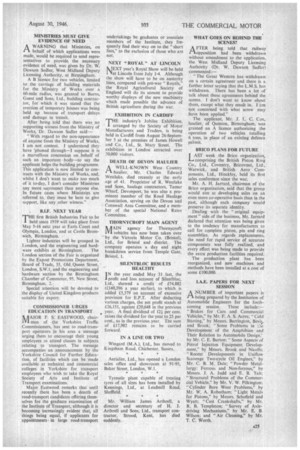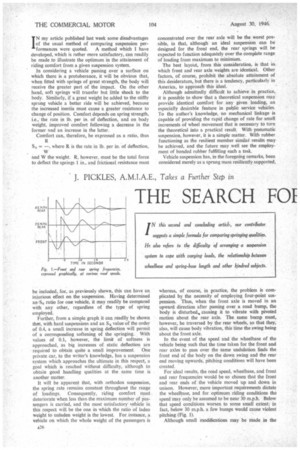MINISTRIES MUST GIVE EVIDENCE OF NEED A WARNING that Ministries,
Page 27

Page 28

If you've noticed an error in this article please click here to report it so we can fix it.
on -1"-t behalf of which applications were made, would be required to send representatives to provide the necessary evidence of need, was given by Dr. W. Dawson Sadler, West Midland Deputy Licensing Authority, at Birertingham.
A B licence for two vehicles, limited to the carriage of building materials for the Ministry of Works over a 60-mile radius, was granted to Bums. Guest and Sons, Ltd., building contractor, for which it was stated that the erection of temporary houses was being held up because of transport delays and damage in transit.
After being told that there was no supporting witness from the Ministry of Works, Dr. Dawson Sadler said:— " With regard to the non-appearance of anyone from the Ministry of Works. I am not content. I understand they have 'phoned through—I suppose it is a marvellous concession on behalf of such an important• body—to say the applicant helps the building programme. This application is now limited to contracts with the Ministry of Works, and, whilst I don't want to make too much of it to-day, I don't consider Ministries any more sacrosanct than anyone else. In future cases where Ministries are referred to, they must be here to give support, like any other witness."
. RIF, NEXT YEAR THE first British Industries Fair to be held since 1939 will take place from May 5-16 next year at Earls Court and Olympia. London, and at Castle Bromwich, Birmingham.
Lighter industries will be grouped in London, and the engineering and hard
ware exhibits at Birmingham. The London section of the Fair is organized by the Export Promotions Department, Board of Trade, 35, Old Queen Street, London, S.W.1, and the engineering and hardware section by the Birmingham Chamber of Commerce, 95, New Street, Birmingham, 2_ Special attention will be devoted to the display of United Kingdom products suitable for export.
COMMISSIONER URGES EDUCATION IN TRANSPORT •
h/lAIOR F. S. EASTWOOD, chairIVI man of -the Yorkshire Traffic Commissioners, has sent to road-transport operators in his area a message urging them to encourage their young employees to attend classes in subjects relating to transport. The message accompanies an announcement by the Yorkshire Council for Further Education, of facilities which can be made available at technical and commercial colleges in Yorkshire for transport employees who wish to take the Royal Society of Arts and Institute of Transport examinations.
Major Eastwood remarks that until recently there has been a dearth of road-transport candidates offering themselves for the graduate examination of the Institute of Transport, although it is becoming increasingly evident that, all things being equal, if applicants for appointmentsin large road-transport
undertakings be graduates or associate members of the Institute, they frequently find their way on to the "short lists," to the exclusion of those who are not.
NEXT "ROYAL" AT -LINCOLN NEXT year's Royal Show will be held at Lincoln from July 1-4. Although the show will have to be on austerity lines, compared with pre-war "Royals," the Royal Agricultural .Society of England will do its utmost to provide worthy displays of the new machinery which made possible the advance of British agriculture during the war.
EXHIBITION IN CARDIFF THE industry's Jubilee Exhibition,
arranged by the Society of Motor Manufacturers and Traders, is being held in Cardiff from August 26-Septemher 5 at the premises of James Howell and Co., Ltd., St. Mary Street. The exhibition in London attracted over 30,000 visitors.
DEATH OF DEVON HAULIER
A WELL-KNOWN West Country rt haulier, Mr. Charles Edward Westlake, died recently at the early age of 41. Proprietor of R. Westlake and Sons, haulage contractors, Tamar Wharf, Devonport, he was also a prominent member of the Road Haulage Association, serving on the Devon and Cornwall Area Committee, and a melther of the special National Rates Committee.
THORNYCRO1FT MAIN AGENT
MAIN agency for Thornycroft 11'1 vehicles has now been taken over by the Victoria Motor Co. (Bristol), Ltd., for Bristol and district. The company operates a day and night breakdown service from Temple Gate, Bristol, I.
SILENTBLOC RESULTS HEALTHY IN the year ended May 31 last, the 1 profit and loss account of Silentbloc, Ltd., showed a credit of £74,882 (£140,396 a year earlier), to which is added £5,379 on account of excessive provision for E.P.T. After deducting various charges, the net profit stands at £26,151, against £20,648 in the previous year. A final dividend of l2 per cent. raises the dividend for the year to 25 per cent., as in the previous year. The sum of £17,982 remains to be carried forward.
IN A LINE OR TWO
Wingard (M.A.), Ltd., has moved to Kingsham Road, Chichester, Sussex.
Aerialite, Ltd., has opened a London sales office and showroom it 91-93, Baker Street, London, W.1.
Tyresole plant capable of treating tyres of all sizes has been installed by Kennings, Ltd., at Leadmill Road, Sheffield.
Mr. William James Arthrell, a director and secretary of H. J. Arthrell and Sons, Ltd., transport contractor, Strood, Kent, has died suddenly.
WHAT GOES ON BEHIND THE SCENES?
AFTER being told that railway opposition had been withdrawn without amendment to the application, the West Midland Deputy Licensing Authority (Dr. W. Dawson Sadler) commented:— The Great Western has withdrawn on a certain agreement and there is a further letter saying that the L.M.S. has withdrawn. There has been a lot of' talk about these agreements behind the scenes. I don't want to know about them, except what they result in. I am not concerned with what screw may have been applied."
The applicant, Mr. J. T.. C. Cox, haulier, of Quinton, Birmingham, was granted an A licence authorizing the operation of two vehicles totalling 6 tons, in place of an existing defence Iselin it.
BRICO PLANS FOR FUTURE AST week the Brico organization, comprising the British Piston Ring Co., Ltd., Coventry, Bricovmo, Ltd., Warwick, and British Aero Components, Ltd., Hinckley, held its first sales conference since the war.
Mr. A. H. Jarrard, chairman of the Brico organization, said that the group would aim at developing sales on an even more co-operative basis than in the past, although each company would preserve its separate identity.
Dealing with the "original equipment" side of the business, Mr. Jarrard declared that attention was being given to the tendency for manufacturers to call for complete piston, pin and ring assemblies. As regards replacements, the need for rapid service of accurate components was fully realized, and every effort was being made to provide the extra production facilities required.
The production plant has been reorganized, and new machines and methods have been installed at a cost of some £100,000.
I.A.E. PAPERS FOR NEXT SESSION
A .NUMBER of important papers is ri being prepared by the Institution of Automobile Engineers for the forthcoming session. These include:— " Brakes for Cars and Commercial Vehicles," by Mr. F. A. S. Acres;" Cold Starting," by Messrs. Barrington, Bevil, and Brook; "Some Problems in tic Development of the Amphibian and Their Relation to Automobile Design,' by Mr. C. E. Burton; "Some Aspects of Petrol Injection Equipment Development," by Messrs. Brook and Nicolls; "Recent Developments in Unillow Scavenge Two-cycle Oil Engines," by Mr. C. B. M. Dale; "Powder Metallurgy: Ferrous and Non-ferrous," by Messrs. J. A. Judd and E. B. Tait; "Structural Problems of the Commercial Vehicle," by Mr. V. W. Pilkington; "Cylinder Bore Wear Problems," by Mr. W. A. Robotham; "Light Metals for Pistons," by, Messrs. Schofield and Wyatt; "Cast Crankshafts," by Mr. R. B, Templeton; "Survey of Axledriving Mechanisms," by Mr. E. B. Wilson; and "Air Cleaning" by Mr. T. C. Worth. IN my article published last week some disadvantages of the usual method of comparing suspension performances were quoted. A method which I have developed, which is rather more satisfactory, can readily be made to illustrate the optimum in the attainment of riding comfort from a given suspension system.
In considering a vehicle passing over a surface on which there is a protuberance, it will be obvious that, when fitted with springs of great strength, the body will receive the greater part of the impact. On the other hand, soft springs will transfer but little shock to the body. Similarly, if a great weight be added to the stiffly sprung vehicle a better ride will be achieved, because the increased inertia must cause a greater resistance to change of position. Comfort depends on spring strength, i.e.. the rate in lb. per in. of deflection, and on body weight, improved comfort following a decrease in the former and an increase in the latter.
Comfort can, therefore, be expressed as. a ratio, thus R S, = —, where R is the rate in lb. per in. of deflection, W
and W the weight. R, however, must be the total force to deflect the springs 1 in.. and frictional resistance must
concentrated over the rear axle will be the worst possible, in that, although an ideal suspension can be designed for the front end, the rear springs will be expected to function adequately over the complete range of loading from maximum to minimum.
The best layout, from this consideration, is that in which front and rear axle weights are identical. Other factors, of course, prohibit the absolute attainment of this desideratum, but there is a tendency, particularly in America, to approach this ideal.
Although admittedly difficult to achieve in practice, it is possible to show that a theoretical suspension may provide identical comfort for any given loading, an especially desirable feature in public service vehicles. To the author's knowledge, no mechanical linkage is capable of providing the rapid change of rate for small increments of wheel movement that is necessary to turn the theoretical into a practical result. With pneumatic suspension, however, it is a simple matter. With rubber functioning as the resilient member similat results may he achieved, and the future may well see the employment of bonded rubber fulfilling such a task.
Vehicle suspension has, in the foregoing remarks, been considered merely as a sprung mass resiliently supported,




































































